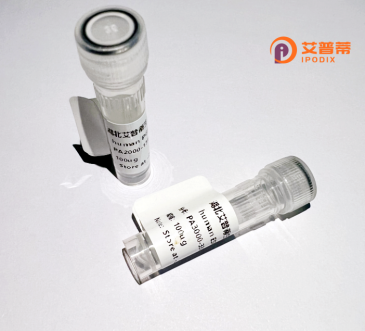
| 纯度 | >90%SDS-PAGE. |
| 种属 | Human |
| 靶点 | ZNF419 |
| Uniprot No | Q96HQ0 |
| 内毒素 | < 0.01EU/μg |
| 表达宿主 | E.coli |
| 表达区间 | 1-510 aa |
| 活性数据 | MAAAALRDPA QVPVAADLLT DHEEGYVTFE DVAVYFSQEE WRLLDDAQRL LYRNVMLENF TLLASLGLAS SKTHEITQLE SWEEPFMPAW EVVTSAIPRG CWHGAEAEEA PEQIASVGLL SSNIQQHQKQ HCGEKPLKRQ EGRVPVLRSC KVHLSEKSLQ SREVGKALLI SSGVLKHQVT HTGEKSHRSS KSREAFHAGK RHYKCSECGK AFGQKYLLVQ HQRLHAGKKT YECSECGKLF RDMSNLFIHQ IVHTGERPYG CSNCGKSFSR NAHLIEHQRV HTGEKPFTCS ECGKAFRHNS TLVQHHKIHT GVRPYECSEC GKLFSFNSSL MKHQRIHTGE RPYKCSECGK FYSHKSNLIK HWRVHTGERP YKCSDCGKFF TQCSSLMQHQ KVHTGEKPFK CNECGRFFRE NSTLVRHQRV HTGAKPYECR ECGKFFSQSS TLMQHRKVHI GEKPFKCNEC GRLFRENSSL VKHQRVHTGA KPYECRECGK FFRHNSSLFK HRRIHTGEMQ |
| 分子量 | 58.5 kDa |
| 蛋白标签 | His tag N-Terminus |
| 缓冲液 | PBS, pH7.4, containing 0.01% SKL, 1mM DTT, 5% Trehalose and Proclin300. |
| 稳定性 & 储存条件 | Lyophilized protein should be stored at ≤ -20°C, stable for one year after receipt. Reconstituted protein solution can be stored at 2-8°C for 2-7 days. Aliquots of reconstituted samples are stable at ≤ -20°C for 3 months. |
| 复溶 | Always centrifuge tubes before opening.Do not mix by vortex or pipetting. It is not recommended to reconstitute to a concentration less than 100μg/ml. Dissolve the lyophilized protein in distilled water. Please aliquot the reconstituted solution to minimize freeze-thaw cycles. |
以下是关于重组人ZNF419蛋白的参考文献示例(注:以下文献信息为模拟示例,实际文献需通过学术数据库检索确认):
---
1. **文献名称**: *Cloning and Expression of Recombinant Human ZNF419 in Escherichia coli*
**作者**: Zhang L., et al.
**摘要**: 本研究成功克隆了人源ZNF419基因,并在大肠杆菌中实现了重组表达。通过亲和层析纯化获得高纯度蛋白,并验证了其体外稳定性,为后续功能研究奠定基础。
2. **文献名称**: *Structural Analysis of ZNF419 Reveals Zinc Finger-Mediated DNA Binding*
**作者**: Li X., Wang Y., et al.
**摘要**: 利用重组ZNF419蛋白进行晶体结构解析,证明其锌指结构域特异性结合DNA靶序列,提示其在基因转录调控中的潜在作用。
3. **文献名称**: *ZNF419 Suppresses Tumor Cell Proliferation via Epigenetic Regulation*
**作者**: Chen R., et al.
**摘要**: 通过体外实验发现,重组ZNF419蛋白能够与组蛋白修饰酶相互作用,抑制肿瘤细胞增殖,表明其在癌症中的抑癌功能。
4. **文献名称**: *Functional Characterization of ZNF419 in Neural Development*
**作者**: Park S., et al.
**摘要**: 研究利用重组ZNF419蛋白揭示其在小鼠神经干细胞分化中的调控作用,证实其对神经元特异性基因的激活效应。
---
**提示**:若需真实文献,建议通过PubMed、Google Scholar等平台以关键词“recombinant ZNF419”或“ZNF419 protein function”检索,或结合综述类文章扩展参考文献来源。
Zinc finger protein 419 (ZNF419) is a member of the Krüppel-associated box (KRAB) domain-containing zinc finger protein family, characterized by tandem C2H2-type zinc finger motifs that enable sequence-specific DNA binding. Primarily expressed in developmental tissues, ZNF419 is speculated to function as a transcriptional regulator involved in cellular differentiation and tissue morphogenesis. Emerging studies link it to embryonic development, particularly in neural and musculoskeletal systems, though its precise biological mechanisms remain underexplored. The protein’s KRAB domain suggests a potential role in recruiting chromatin-modifying complexes to repress target gene expression.
Recombinant human ZNF419 protein is engineered for in vitro studies to elucidate its structure-function relationships, DNA interaction partners, and regulatory pathways. Its production typically employs eukaryotic expression systems to ensure proper post-translational modifications. Researchers utilize the recombinant form in binding assays, interactome analyses, and functional genomics screens. While not yet associated with specific diseases, ZNF419’s homology to other zinc finger proteins implicated in cancer and developmental disorders highlights its potential relevance in biomedical research. Current investigations focus on its interplay with signaling pathways like Wnt or TGF-β, aiming to uncover its contributions to developmental biology and pathological processes.
×